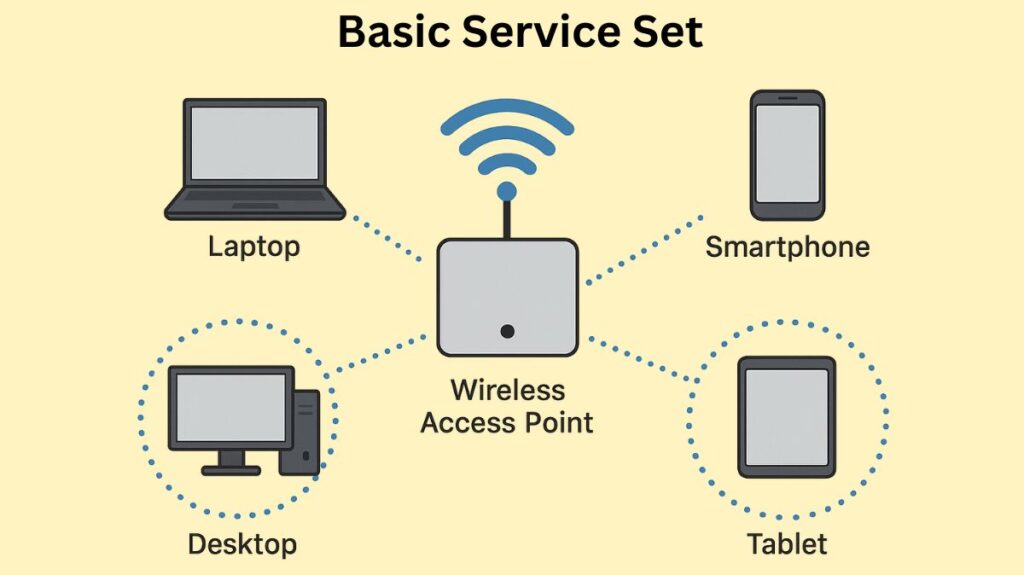Basic Service Set
The foundational component of an IEEE 802.11 (Wi-Fi) wireless local area network (WLAN) is the Basic Service Set (BSS). A logical network segment is a collection of wireless devices (referred to as stations or STAs) that may communicate with one another.
Around a fixed device, usually the Access Point (AP), a BSS creates a closed group of mobile devices. The Basic Service region (BSA), often known as a cell, is the actual region that the BSS covers and is delineated by the AP’s signal range.

You can also read Basic Service Area Definition, Function and Architecture
Two Main Types of Basic Service Set
The way wireless devices communicate defines a BSS’s structure:
Infrastructure BSS (Most Common Type)
Operating in infrastructure mode, this is the typical Wi-Fi network found in homes and workplaces.
- Structure: An Access Point (AP) serves as the main hub and is the source of all communication.
- Components: One AP and one or more Station Clients (STAs), which include gadgets like computers, phones, and tablets, make up its components.
- Traffic Flow: All data must be sent to the AP, which subsequently forwards it to the intended location. Client devices do not speak to one another directly.
- Connectivity: The AP also serves as a translational bridge, linking the wireless devices to the upstream wired network (such as Ethernet) called the Distribution System (DS). The AP transforms frames between 802.3 Ethernet and 802.11 wireless protocols.
- Association: A wireless device must submit an association request to the AP in order to join an Infrastructure BSS, and the AP must decide whether to accept or reject the request.
Independent BSS (IBSS) or Ad Hoc Network
A central AP is not required to set up this kind of BSS.
- Structure: Peer-to-peer direct communication between devices is used.
- Coordination: A wired network does not have a central coordinator or gateway. The first station in the ad hoc network establishes certain duties, such as specifying network parameters and “beaconing” operations.
- Use Case: Frequently employed for transient connections, including file sharing between two laptops or setting up a mobile hotspot on a smartphone. Generally speaking, these networks don’t scale well beyond eight or ten devices.
You can also read Advantages Of Transport Layer Security TSL And How It Works
Key Identifiers of a BSS
A BSS must be defined and managed using two key identifiers:
- Basic Service Set Identifier (BSSID):
- According to MAC-48 standards, this is the BSS’s unique 48-bit machine-readable identifier.
- The MAC address of the wireless radio of the access point is usually the BSSID in an infrastructure BSS.
- Especially in settings with several APs, the BSSID is used to address packets inside the BSS and guarantees that devices correctly identify the specific access point to which they are connected.
- Service Set Identifier (SSID):
- This is the network’s name that can be read by humans, such as “Office-Guest.”
- To signal the existence of the network, the AP broadcasts the SSID in beacon frames.
- Since every device in the BSS uses the same SSID, the SSID, which is a text string up to 32 octets long, aids with network unification.
Operation and Characteristics
- Channel Use: Usually, a BSS needs just one wireless channel to function.
- Security: Similar to ESS, BSS is capable of putting security features like authentication and encryption into practice. Important security measures include secure authentication (like 802.1X) and strong encryption (WPA3 is advised).
- Multi-SSID: By assigning a distinct VLAN to each SSID, a single physical AP can accommodate several logical BSSs. In this scenario, every logical BSS will have its own BSSID, which is often obtained by increasing the MAC address of the radio.
BSS in Larger Networks (ESS)
The BSS does not support roaming by default and is constrained by the range of a single AP. BSSs are employed as building blocks for more extensive network topologies in order to get around these restrictions:
Extended Service Set (ESS): When two or more BSSs are linked together using a single wired Distribution System (DS), an ESS is created. Wireless clients can roam automatically and smoothly from one BSS (AP) to another while keeping a consistent SSID; this arrangement forms a single, seamless network.
Advantages and Disadvantages
| Feature | Description |
|---|---|
| Advantages | Simplicity and cost-effectiveness for small-scale networks. |
| Easy to set up, requiring only a single AP and client devices. | |
| Lower latency compared to ESS. | |
| Reduced risk of interference because each BSS can operate on its own frequency. | |
| Disadvantages | Limited coverage area (restricted by the single AP’s signal range). |
| Limited scalability beyond a certain point. | |
| Limited mobility; clients cannot seamlessly roam between different BSSs. | |
| Lack of centralized control in an Independent BSS (which can lead to inefficiencies and security risks). |
You can also read What is the Cisco AnyConnect Secure Mobility Client in CCNA
